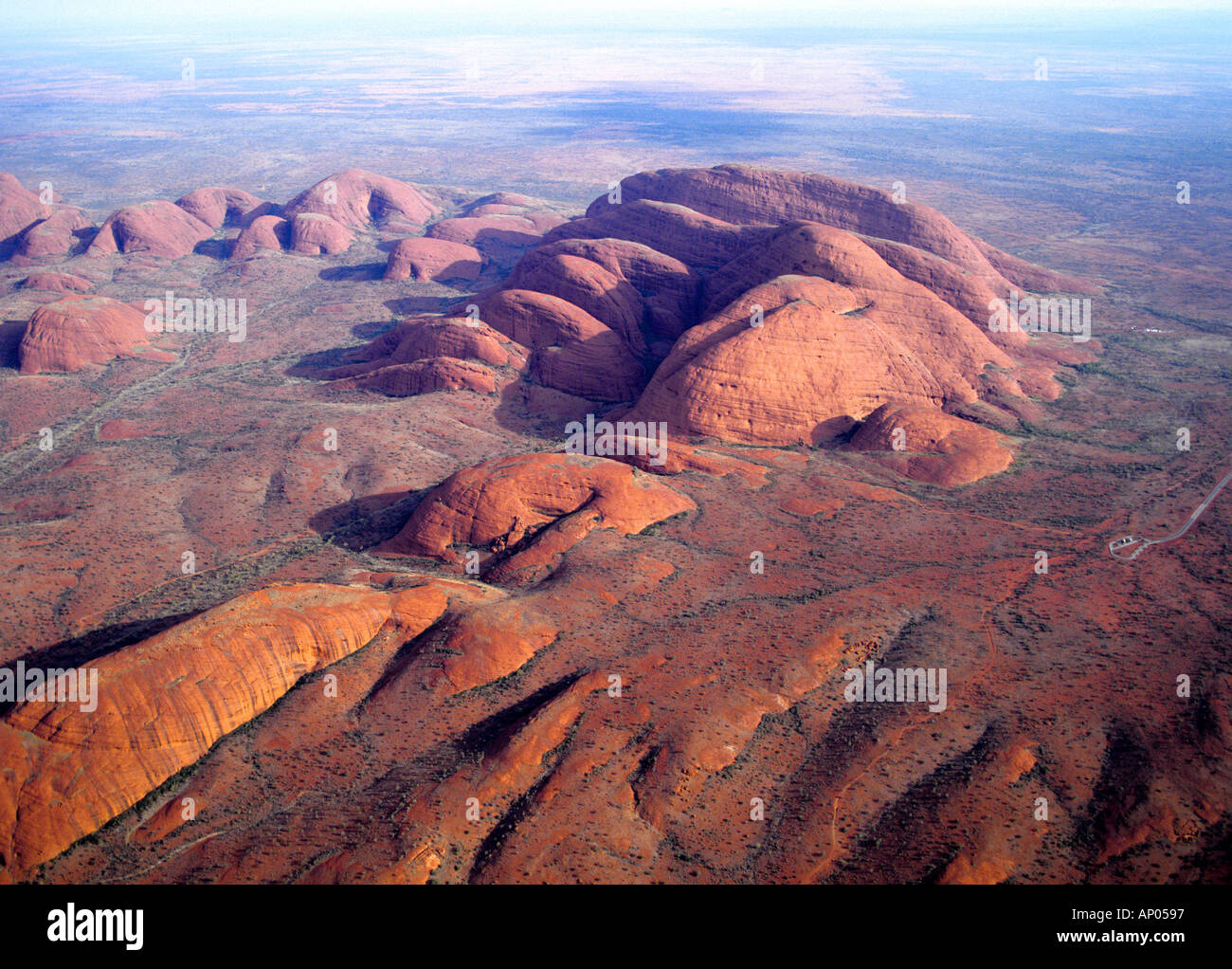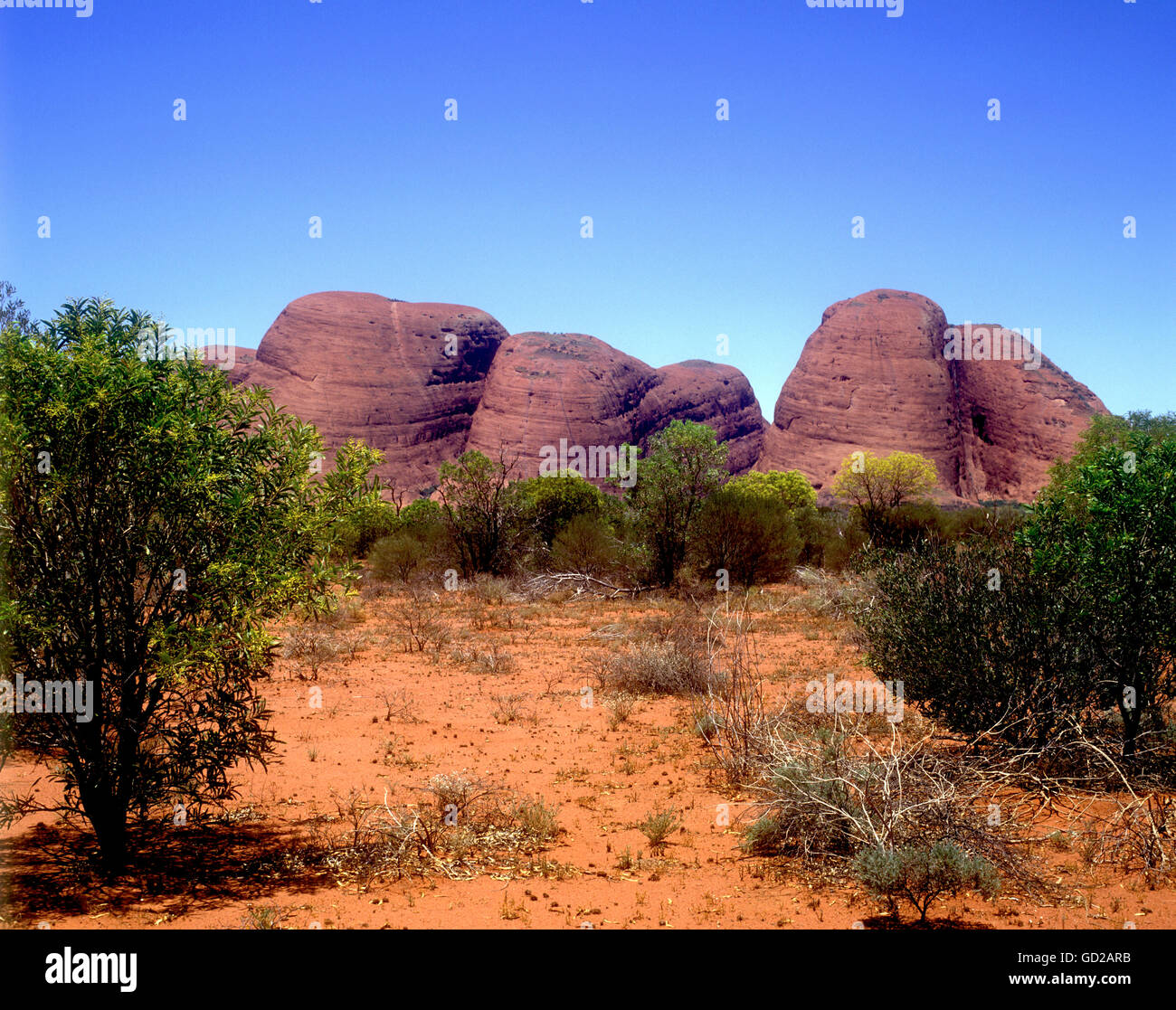
Aerial view of Mount Olga Northern Territory Australia Stock Photo 1443222 Alamy
Kata Tjuta, and also known as Mount Olga (or colloquially as The Olgas), are a group of large domed rock formations or bornhardts located about 365 km (227 m.

Mount Olgas, Australia, UluruKata Tjuta National Park, Ayers Rock Stock Photo Alamy
The highest dome, Mount Olga, is 1,066 m (3,497 ft) above sea level, or approximately 546 m (1,791 ft) above the surrounding plain 198 m (650 ft) higher than Uluṟu). [1] Kata Tjuṯa is located at the eastern end of the Docker River Road. The other name, The Olgas, comes from the tallest peak, Mount Olga.

Australia Northern Territory The Olgas (Kata Tjuta) Mount Olga in the Uluru Kata Tjuta
One of the highest peaks on the continent is called Mount Olga after the daughter of Nicholas I. An enormous red rock in Australia's Uluru-Kata Tjuta National Park, visible from afar, is a.

Mount Olga Australia Also known as Katajuta, are a group of large domed rock formations
description and height In Olgas.National Park) and culminate at Mount Olga, 1,500 feet (460 metres) above the plain and 3,507 feet above sea level. Mount Olga is the most westerly of Australia's three giant tors; the others are Uluru/Ayers Rock and Mount Conner (Artilla). They were visited and named in 1872 after Queen Olga… Read More

Aerial view of Mount Olga Northern Territory Australia Stock Photo 1443220 Alamy
In 1959, the area of the reserve that included Ulu r u and Kata Tju t a - known then as Ayers Rock and Mount Olga by white settlers - was excised for use by tour companies, and A n angu were forced from the area. By the 1970s, Ayers Rock-Mount Olga was the most famous stop on the outback tourist circuit.

Kata Tjuta (Mount Olga) Australia peakery
This park, formerly called Uluru (Ayers Rock - Mount Olga) National Park, features spectacular geological formations that dominate the vast red sandy plain of central Australia.

Kata Tjuta, Mount Olga, Australia (with Map & Photos)
Australia's Red Centre is home to natural wonder and cultural landmark, Kata Tju t a (the Olgas). Hike around the soaring rock domes, which glow at sunrise and sunset. Located approximately 40km west of Ulu r u, the ochre-coloured shapes are an intriguing and mesmerising sight. Take a walk

Kata Tjuta (Mount Olga), Australia Stock Image C018/2517 Science Photo Library
Kata Tjuta (Mount Olga) is located in the Uluru-Kata-Tjuta National Park of Australia and consists of 36 massive rounded rocks, many gorges and valleys. Its second name is Kata Tjuta, which means "many heads" in the Aboriginal language. Kata Tjuta Australia History

Mt Olga,Australia
Book your tickets online for Kata Tjuta - The Olgas, Uluru-Kata Tjuta National Park: See 2,312 reviews, articles, and 2,104 photos of Kata Tjuta - The Olgas, ranked No.3 on Tripadvisor among 15 attractions in Uluru-Kata Tjuta National Park.. Mount Gambier, Australia 45 contributions. 0. Extraordinary. Jun. 2023. What a fabulous sight to see.

Kata Tjuta also known as Mount Olga (or colloquially as The Olgas) is located in the
For a long time known exclusively as 'The Olgas' or 'Mount Olga' after its highest peak, the famous domes of Kata Tjuta must be seen to be believed. Credit: Tourism Australia Considered a must-do for anyone travelling to the Northern Territory, read on to find out everything you need to know about Kata Tjuta before you arrive!

Wallpaper kata tjuta, mount olga, uluru, australia, evening, clouds, rock desktop wallpaper
Mount Olga is the most westerly of Australia's three giant tors; the others are Uluru/Ayers Rock and Mount Conner (Artilla). They were visited and named in 1872 after Queen Olga of Württemberg by the explorer Ernest Giles. Their Aboriginal name, Kata Tjuta, means "many heads."

Kata Tjuta (Mount Olga), Northern Territory, Australia Aerial view, Science images, Aerial
Rising to more than 546 metres above ground level, the highest point of the structure is Mount Olga, a peak that sits more than 200 metres higher than Uluru. All in all, it measures around 22 kilometres in circumference, so it is again bigger (and somewhat more impressive) than Uluru.

Mt Olga Northern Territory, Australia Australia, Northern territory, Natural landmarks
The nickname of 'the Olgas' most likely developed when the area was opened up to tourists in the 1950s. Mount Olga was the official name until 1993, when the feature was given dual names: Mount Olga / Kata Tju t a. In 2002 the order was officially reversed to put the original name first: Kata Tju t a / Mount Olga.

Australia Mount Olga Stock Photo Alamy
It might not be as instantly recognisable as Uluru, but Kata Tjuta is just as impressive as its famous neighbour.. Formerly known as the Olgas, the 36 domes of Kata Tjuta cover more than 20 square kilometres and soar up to 546 metres above the surrounding plain.'Kata Tjuta' is a Pitjantjatjara term that means 'many heads'.. For Anangu, Kata Tjuta is an extremely important site for men.

Kata Tjuta (Mount Olga), Australia Stock Image C018/2515 Science Photo Library
Giles named the largest dome Mount Olga, after Queen Olga of Württemberg. In 1873 another explorer, William Gosse, became the first non-Aboriginal person to see Uluru, naming it Ayers Rock after the Chief Secretary of South Australia, Sir Henry Ayers. The next major expedition to the area was a scientific team in 1894.

Explore Kata Tjuta, Mount Olga, Australia See More at Outback australia
Uluṟu-Kata Tjuṯa National Park is a protected area in the Northern Territory of Australia.The park is home to both Uluru and Kata Tjuta.It is located 1,943 kilometres (1,207 mi) south of Darwin by road and 440 kilometres (270 mi) south-west of Alice Springs along the Stuart and Lasseter Highways. The park covers 1,326 square kilometres (512 sq mi) and includes the features it is named.